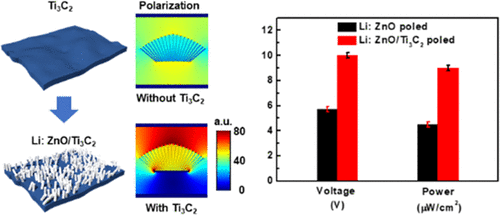当前位置:
X-MOL 学术
›
ACS Appl. Mater. Interfaces
›
论文详情
Our official English website, www.x-mol.net, welcomes your feedback! (Note: you will need to create a separate account there.)
Enhanced Output Performance of a Flexible Piezoelectric Nanogenerator Realized by Lithium-Doped Zinc Oxide Nanowires Decorated on MXene
ACS Applied Materials & Interfaces ( IF 9.5 ) Pub Date : 2022-06-06 , DOI: 10.1021/acsami.2c05857 Viet Anh Cao 1 , Minje Kim 1 , Sol Lee 1 , Chang Geun Kim 1 , Phuoc Cao Van 2 , Trinh Nguyen Thi 2 , Jong-Ryul Jeong 2 , Junghyo Nah 1
ACS Applied Materials & Interfaces ( IF 9.5 ) Pub Date : 2022-06-06 , DOI: 10.1021/acsami.2c05857 Viet Anh Cao 1 , Minje Kim 1 , Sol Lee 1 , Chang Geun Kim 1 , Phuoc Cao Van 2 , Trinh Nguyen Thi 2 , Jong-Ryul Jeong 2 , Junghyo Nah 1
Affiliation

|
A flexible piezoelectric composite is composed of a polymer matrix and piezoelectric ceramic fillers to achieve good mechanical flexibility and processability. The overall piezoelectric performance of a composite is largely determined by the piezoelectric filler inside. Thus, different dispersion methods and additives that can promote the dispersion of piezoelectric ceramics and optimal composite structures have been actively investigated. However, relatively few attempts have been made to develop a filler that can effectively contribute to the performance enhancement of piezoelectric devices. In the present work, we introduce the fabrication and performance of the composite piezoelectric devices composed of Li-doped ZnO nanowires (Li: ZnO NWs) grown on the surface of MXene (Ti3C2) via the hydrothermal process. Through this approach, a semiconductor–metal hybrid structure is formed, increasing the overall permittivity. Moreover, the Ti3C2 layer can serve as a local ground in the composite so that the ferroelectric phase-transformed Li: ZnO NWs grown on its surface can be more effectively polarized during the poling process. In addition, the NW-covered surface of Ti3C2 prevents the aggregation of metallic Ti3C2 particles, promoting a more uniform electric field distribution during the poling process. As a result, the output performance of the piezoelectric nanogenerator (PENG) fabricated with a Li: ZnO NW/Ti3C2 composite was greatly improved compared to that of the devices fabricated with Li: ZnO NWs without the Ti3C2 platform. Specifically, the Li: ZnO NW/Ti3C2 composite piezoelectric nanogenerator (PENG) demonstrated a twofold higher output power density (∼9 μW/cm2) compared with the values obtained from the PENG devices based on Li: ZnO NWs. The approach introduced in this work can be easily adopted for an effective ferroelectric filler design to improve the output performance of the piezoelectric composite.
中文翻译:

由装饰在 MXene 上的锂掺杂氧化锌纳米线实现的柔性压电纳米发电机的增强输出性能
柔性压电复合材料由聚合物基体和压电陶瓷填料组成,以实现良好的机械柔韧性和可加工性。复合材料的整体压电性能很大程度上取决于内部的压电填料。因此,可以促进压电陶瓷分散和优化复合结构的不同分散方法和添加剂已被积极研究。然而,相对较少的尝试来开发能够有效地促进压电器件性能增强的填料。在目前的工作中,我们介绍了由在 MXene (Ti 3 C 2 )表面上生长的锂掺杂 ZnO 纳米线 (Li: ZnO NWs) 组成的复合压电器件的制造和性能。通过水热过程。通过这种方法,形成了半导体-金属混合结构,从而提高了整体介电常数。此外,Ti 3 C 2层可以作为复合材料中的局部接地层,使得在其表面生长的铁电相变 Li: ZnO NWs 在极化过程中可以更有效地极化。此外,Ti 3 C 2 的 NW 覆盖表面可防止金属Ti 3 C 2 颗粒的聚集,从而在极化过程中促进更均匀的电场分布。结果,用 Li: ZnO NW/Ti 3 C制造的压电纳米发电机 (PENG) 的输出性能与用Li: ZnO NWs 制造的没有Ti 3 C 2平台的器件相比,2复合材料得到了极大的改进。具体来说,Li: ZnO NW/Ti 3 C 2复合压电纳米发电机 (PENG) 的输出功率密度 (~9 μW/cm 2 ) 是基于 Li: ZnO NW 的 PENG 器件的两倍。这项工作中介绍的方法可以很容易地用于有效的铁电填料设计,以提高压电复合材料的输出性能。
更新日期:2022-06-06
中文翻译:

由装饰在 MXene 上的锂掺杂氧化锌纳米线实现的柔性压电纳米发电机的增强输出性能
柔性压电复合材料由聚合物基体和压电陶瓷填料组成,以实现良好的机械柔韧性和可加工性。复合材料的整体压电性能很大程度上取决于内部的压电填料。因此,可以促进压电陶瓷分散和优化复合结构的不同分散方法和添加剂已被积极研究。然而,相对较少的尝试来开发能够有效地促进压电器件性能增强的填料。在目前的工作中,我们介绍了由在 MXene (Ti 3 C 2 )表面上生长的锂掺杂 ZnO 纳米线 (Li: ZnO NWs) 组成的复合压电器件的制造和性能。通过水热过程。通过这种方法,形成了半导体-金属混合结构,从而提高了整体介电常数。此外,Ti 3 C 2层可以作为复合材料中的局部接地层,使得在其表面生长的铁电相变 Li: ZnO NWs 在极化过程中可以更有效地极化。此外,Ti 3 C 2 的 NW 覆盖表面可防止金属Ti 3 C 2 颗粒的聚集,从而在极化过程中促进更均匀的电场分布。结果,用 Li: ZnO NW/Ti 3 C制造的压电纳米发电机 (PENG) 的输出性能与用Li: ZnO NWs 制造的没有Ti 3 C 2平台的器件相比,2复合材料得到了极大的改进。具体来说,Li: ZnO NW/Ti 3 C 2复合压电纳米发电机 (PENG) 的输出功率密度 (~9 μW/cm 2 ) 是基于 Li: ZnO NW 的 PENG 器件的两倍。这项工作中介绍的方法可以很容易地用于有效的铁电填料设计,以提高压电复合材料的输出性能。


























 京公网安备 11010802027423号
京公网安备 11010802027423号